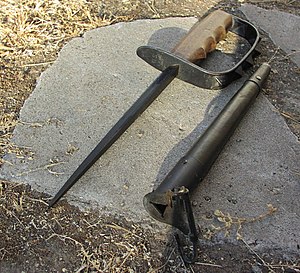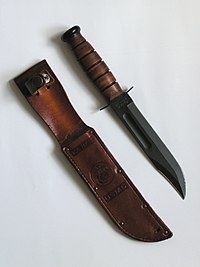Trench knife: Difference between revisions
Thumperward (talk | contribs) →U.S. trench knives: tidy use of ref |
No edit summary |
||
| Line 65: | Line 65: | ||
==External links== |
==External links== |
||
* [http://arms2armor.com/Knives/m1trench.htm Images] |
* [http://arms2armor.com/Knives/m1trench.htm Images] |
||
{{Knives}} |
{{Knives}} |
||
Revision as of 17:03, 8 December 2008


Trench knives are either purpose-made weapons, or are made from cut-down (shortened) bayonets or swords, and intended for close-quarter fighting, the design originating in the trench warfare of the First World War. They were particularly useful for trench raiding operations, along with other mêlée weapons.
U.S. trench knives
Perhaps the most easily recognized American trench knife is the Mark I, introduced too late to see World War I service in the trenches, but adopted and carried by U.S. paratroopers in the Second World War. This knife was a full-tang design with a double-edged blade and a brass hilt incorporating a guard shaped as a knuckle duster, though the guard existed much more for the purpose of being a guard than for any perceived benefit as a punching aid. The pommel incorporated a 'skull-crusher' extension designed to increase the flexibility and thus lethality of the weapon (although this may have been ineffective in combat[1]) and that use of the pommel rather than the blade is less lethal option).
The Mark I was preceded by the U.S. M1917 and M1918 trench knives, which featured more complex designs including a triangular stiletto blade, wooden grip, metal knuckle guard, and a rounded pommel. The two versions differed primarily in the construction and appearance of their knuckle guards.
The brass-hilted U.S. Mark I trench knives were made by three American companies -- Landers, Frary & Clark (L.F.&C.) of New Britain, CT; Henry Disston & Sons (HD&S) of Philadelphia, PA; and Oneida Community Limited (O.C.L.) -- and one French company (Au Lion/Societe General). American models of the Mark I are stamped on the right side of the brass grip "U.S. 1918", with the contractor's initials below that. These three American companies were among the four that also made the earlier U.S. M1917 and M1918 trench knives.
The French version of the Mark I is stamped on the blade ricasso with a recumbent lion, and "Au Lion" below that. The grip of the French version is typically stamped with "U.S. 1918". Several versions of the French model exist - some with grooves on top of the grip, some without. Some have letters and numbers cast into the knucks that are smaller than others.
The American Mark I knives and steel sheaths were issued with a blackened finish to prevent reflection, but some owners believing this to be tarnish attempted to polish them and remove the blackening. The French knives were issued with iron sheaths. American versions of the Mark I appear to be better finished than the French version, and are slightly larger dimensionally as well. American-made sheaths for the Mark I trench knife are marked "L.F.&C. 1918", while the French sheath is unmarked. American-made knives have 8-sided skull-crusher pommels, the French model is 4-sided.
Other fighting knives used by U.S. forces are sometimes referred to as trench knives, indicating their purpose. These include the stiletto-shaped daggers carried by Marine Corps Raiders in World War II, and fighting-utility knives made by Ka-Bar and other manufacturers.
British & Commonwealth trench knives

The British Army and its Commonwealth allies (eg Australia, Canada & New Zealand) used a wide variety of trench knives during World War I. Some were privately purchased commercial models based on Bowie knives. Others were more specialised types eg push daggers with a roughly cylindrical aluminium grip which was shaped to fit comfortably when the user's hand made a fist. The attached 4 inch blade protruded between the knuckles of the user. It was common British practice for trench knives to be used in combination with other "quiet" weapons during trench raiding expeditions eg trench clubs, pick-axe handles and hatchets - backed up with revolvers and grenades. Years later, during the Second World War, the Fairbairn-Sykes Knife was widely issued to British commando type forces such as the Royal Marines, Parachute Regiment, Special Boat Service and the Special Air Service. Though not a true "trench knife" per se, the Fairbairn-Sykes was used for similar purposes.
German trench knives
The German Army used similar trench knives in the First and Second World Wars, often featuring a wooden or, in some cases, all-metal or composition plastic handle.
During World War I, some German trench knives were privately purchased, but many standardized versions were made by government contractors and officially issued. Most had slab wooden grips and metal sheaths and were sturdily made. According to one authoritative source, German-issued trench knives of World War I were "...conventional, general-purpose, cut-and-thrust knives..." with blades that were "...for the most part approximately six inches in length, single-edged with a top leading false edge...although double-edged blades are occasionally encountered." [2]
German trench knives carried during World War II were similar in design and are usually known today as boot knives, although they seldom were carried in boots. Most also had steel sheaths but with clips that could be attached to boots or clothing, and most were made by government contractors and issued as combat gear.
Trench Knives in Popular Culture
- Popular G.I. Joe: A Real American Hero character Snake-Eyes has an extensive collection of spike-knuckled trench knives.
- The Zombie Survival Guide praises the trench spike as "the best compact anti-zombie weapon on earth".
- The character "Bobby Maxwell" (played by DeVeren Bookwalter) in the Clint Eastwood movie "The Enforcer" carried a Mk. I Model 1918 (brass knuckle) trench knife.
- Lee Marvin's character "The Sergeant" in Samuel Fuller's "The Big Red One" carried a Mk. I Model 1918 (brass knuckle) trench knife.
- Frank Sinatra's character "Cpt. Tom Reynolds" in the John Sturges movie "Never So Few" carried a Model 1917 (triangular bladed) trench knife.
- Roberta, a military-trained assassin in Black Lagoon, uses a trench spike amongst a vast array of weaponry.
- William H. Macy's character in the film Edmond carries a 1918 model Trench Knife.
- Roland Weary in Slaughterhouse Five carries a three-bladed trench knife with a spiked knuckle at all times, and often describes its various properites.
- Sylvester Stallone has been an avid knife collector for many years. In the first "Rocky" movie, he has an M1917 (triangular bladed) trench knife stuck in a corner on top of his dresser bureau (to the right of the mirror), and there is a Mk. I M1918 (brass knuckle) trench knife stuck in a side near the top of his dresser bureau.
- Kane of Kane & Lynch: Dead Men wields a trench spike of unknown model throughout the game.
- Can be used in the MMO Dead Frontier and is quite powerful.
- Sarutobi Asuma of the anime Naruto uses two trench-knives of the knuckle-duster variety as his weapons of choice. After his death, they are taken and used by his pupil Shikamaru.
Reference literature
- Frederick J. Stephens Author of: Fighting Knives: Illustrated Guide to Fighting Knives and Military Survival Weapons of the World
See also
References
- ^ http://www.888knivesrus.com/category/allbrands.sheffield_knives.sfstory
- ^ Johnson, Thomas M., LTC (Ret.) & Wittmann, Thomas T.: Collecting the Edged Weapons of Imperial Germany, Vol. I, Privately published, 1988, p. 317. ISBN 0-9600906-0-6
